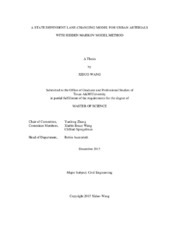| dc.description.abstract | The inherent intention and decision process of lane changes are complex and unobservable. Though the external environment and traffic conditions are changing along the traveling direction, the drivers’ characteristics and preferences may lead to persistence of preferable lane choices. Hidden Markov Model (HMM) method is used to model the system that involves unobservable factors, such as speech recognition and biological sequence problems. The hidden process are assumed to associate with observable outcomes.
In this study, HMM is integrated into a two-stage lane-changing model to better represent the mandatory lane-changing behaviors on arterials. The lane-changing decision process is separated into two steps: decision to target a lane as the desire lane and acceptance of available gaps in the chosen direction. The outcome of the first step is unobservable and treated as the latent state in HMM. The second step, gap acceptance model, relates the outcome of the first step to observed vehicle trajectories.
The proposed model is estimated and validated using detail Next Generation Simulation (NGSIM) vehicle trajectory data from Lankershim Boulevard. Comparison between generated lane position sequences and original trajectories validated the model’s capability of representing mandatory lane changes. There is an average 17% difference on predicted lane change locations compared to observed locations; while lane change locations to left turn lane and right turn lane show 10% and 13% difference respectively. The generated lane changes show a late tendency of movements among through lanes. The results show that the model is fit for the purpose of representing mandatory lane change behaviors on arterials. The research highlights some future improvements of proposed lane-changing model on arterials. | en |


